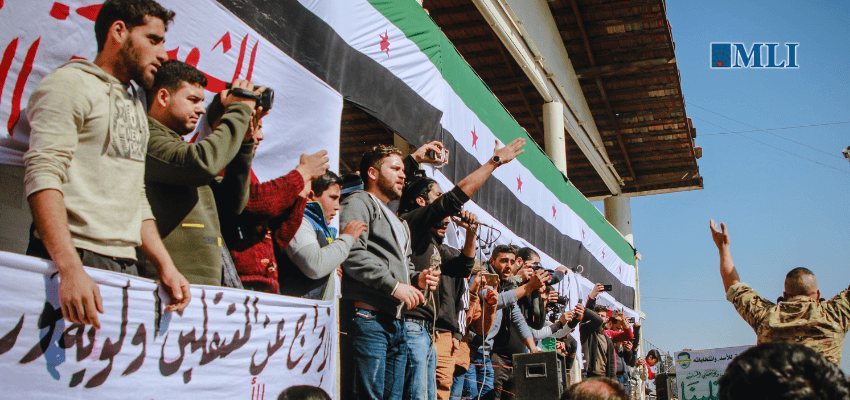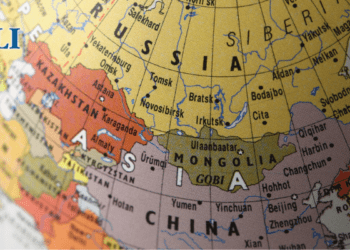By Sercan Canbolat, January 13, 2025
In a shockingly swift turn of events, a coalition of armed opposition groups has overthrown the Assad dynasty that ruled Syria more for than a half-century. It took less than two weeks for the armed groups, led by Hay’at Tahrir al-Sham (HTS), to oust the Russian-backed Assad regime and send President Bashar al-Assad fleeing into exile.
Since the Syrian civil war erupted in 2015, between 300,000 and 620,000 people have died, making it the second-deadliest conflict of the 21st century after the Second Congo War. Thanks to nearly a decade of conflict, around 7 million Syrians are internally displaced and more than 5 million are living as refugees in more than 20 host countries around the world, including Canada, which hosts around 60,000 Syrian refugees.
The abrupt end to the stalemate of a war in Syria will have reverberations around the Middle East and North Africa (MENA) region and beyond. Amidst a cascade of developments in Syria since the fall of the Baath regime, it is important to distinguish “signals from noise.” What happens next in Syria will be of paramount importance to Canada and other host countries, as well as to the Syrian refugees who wish to someday return to their homeland. However, to outside observers, many questions arise: who exactly are these victorious armed groups? Will Syria choose democracy – or succumb to hardline Islamism? What are the short- and longer-term implications? Here’s what you need to know.
The roots of the conflict
In 2011, a series of Arab uprisings swept the Middle East, particularly in Tunisia and Egypt, but also in Syria. However, the Syrian protest movement was swiftly beaten down by the Assad regime. Assad’s iron-fisted response, which included the use of deadly force, sparked wider protests throughout country and the formation of various Islamist armed groups backed by regional and international powers including Türkiye, Qatar, and the United States. As the opposition forces threatened the Assad regime’s survival in 2015, Syria’s allies, Iran and Hezbollah, stepped up their support, and Russia intervened in Syria militarily. Meanwhile, with the increasing involvement of al-Qaeda in Syria’s civil war and the rise of Daesh (ISIS) in neighbouring Iraq, the Syrian opposition jettisoned its more moderate actors – replacing them with more powerful al-Qaeda-laced organizations including Jabhat al-Nusra (al-Nusra Front) and Daesh.
By 2014, Daesh and Jabhat al-Nusra had emerged as arguably the strongest Syrian opposition actors seeking to defeat the secular Baath regime and establish an Islamic state in Syria. At the same time, the fear and threat of ever-expanding ISIS rule in Iraq and Syria forced the creation of a global coalition led by the US to combat ISIS in the region. The international coalition, along with its partners, the Kurdish-led Syrian Democratic Forces (SDF), soundly defeated ISIS, reclaiming 95 per cent of ISIS’s territory in Syria in 2017. Following this success, the SDF – backed by US air cover and around 2,000 American soldiers on the ground – became an important player in northeastern Syria.
Several peace plans to resolve the Syrian civil war notwithstanding, Astana talks initiated in 2016 by Russia, Türkiye, and Iran had been more decisive in determining the trajectory and main actors of the conflict. The Astana process from 2016 to 2020 produced temporary ceasefires and led to the establishment of a security corridor with joint Turkish and Russian patrols among three zones of influence, the HTS-ruled Northwest, the SDF-led Northeast and the Assad regime in the rest of the country, barring the American al-Tanf garrison on the Jordanian border. The status quo had been largely maintained as Russia and Türkiye declared a ceasefire in Idlib in 2020, the last enclave of Islamist opposition led by HTS in the country. However, the prospects for the termination of the civil war and permanent peace proved stillborn during the Astana process, plunging Syria into a stalemate until a final showdown. This face-off transpired in December 2024 when several opposition groups formed a new coalition called the “Military Operations Command” and launched the “Deterrence of Aggression” operation against all the government forces in the country. This operation culminated in the ouster of President al-Assad on December 8, 2024.
Who’s who in the Syrian conflict?
This is a million-dollar question as tens of thousands of domestic and foreign fighters with third-party sponsorship have been involved in the Syrian conflict since 2011. There has been a plethora of armed groups in Syria whose names, alliances, and allegiances are in flux as the balance of power on the ground and the type as well as magnitude of external backing changed over the years. Nevertheless, most, if not all, armed groups belong to one of three networks today: the Turkish-backed Free Syrian Army (FSA), HTS-led Islamist groups, and the US-backed SDF led by Kurdish People’s Protection Units (YPG and YPJ).
While FSA had presented itself as an alternative government to the Assad regime since the outset of the Syrian civil war, it has been at best a loosely coordinated umbrella organization for myriad local militias who have opposed the Syrian regime since the 1970 coup by Hafez al-Assad. Characterized early on as a “moderate” group compared to Jabhat al-Nusra and Daesh by the Obama administration, FSA received support from the US through the Syria Train and Equip Program between 2014 and 2015. While Türkiye played a role in training and equipping the Syrian opposition forces, the Erdogan government opposed the inclusion of the Kurdish-led SDF in this program by declaring that SDF is “endangering our (Türkiye’s) future.” In addition to Ankara’s opposition, Washington has been leery of FSA-affiliated groups’ ideology and their relationship to extremist groups (e.g. Daesh and Jabhat al-Nusra), who might seize the US aid and heavy weaponry. After the Obama administration suspended the train and equip program for the FSA in 2015, the Turkish government became the main sponsor of FSA (also known as Syrian National Army (SNA)) whose command and headquarters were first located in Türkiye.
SDF was formed as a coalition of the US-backed Kurdish forces (namely, The People’s Defense Units ()) and major Arab tribes in northeastern Syria in 2015. SDF is affiliated with the Kurdish political party Democratic Union Party (PYD), which de facto presides over the northern Syrian cantons known as Rojava. PYD aims to create an autonomous entity in Rojava and envisions a decentralized Syria in the post-civil war era. Türkiye and Turkish-backed Syrian forces, however, fervently oppose the idea of autonomous Rojava and claim PYD has ties to Kurdistan Workers’ Party (PKK), an armed group listed as a terrorist organization by Türkiye and many countries including the US and Canada. The Turkish army and its ally FSA have been fighting SDF in northern Syria since the formation of the latter despite Washington’s dissent.
HTS was founded in January 2017 as a merger between many self-proclaimed Islamist militias, most of whom were former al-Qaeda affiliates in Syria including Jabhat Fatah al-Sham and Jabhat al-Nusra. In 2018, the US government designated HTS as a foreign terrorist organization (FTO) and placed a $10 million bounty on its top leader Ahmed al-Sharaa whose nom de guerre was Abu Mohammad al-Jolani. While HTS formally announced that it is “an independent entity that follows no organization or party, al-Qaeda or others,” both United Nations monitors and US government intelligence services confirmed an ongoing communication and operational relationship between HTS and al-Qaeda organizations. Such reports and findings notwithstanding, the US has recently lifted its bounty on the HTS leader and, as of early January 2025, was considering removing the group’s Foreign Terrorist Organization designation.
The question is, has the HTS moderated its views enough to warrant this change in designation? During my research on leadership characteristics of Islamist armed groups in the region –including former ISIS chief Abu Bakr al-Baghdadi and current HTS (formerly Jabhat al-Nusra) leader Ahmed al-Sharaa (formerly Abu Mohammad al-Jolani) – I found that al-Jolani’s political beliefs regarding the exercising of power, use of brute force to attain political goals, and the perception of control in shaping politics are analogous to the late ISIS leader al-Baghdadi. In my view, al-Jolani – and by extension, HTS, does not exhibit characteristics of “moderate” and/or “average” political leadership.
What does Assad’s fall mean for regional and international powers?
The ouster of the Assad dynasty will have ripple effects far beyond its borders. While Syria is still in flux, there are some observable implications for regional and global powers. First, the unravelling of Assad’s regime dealt a fatal blow to the “Axis of Resistance” that Iran painstakingly constructed since the Islamic revolution of 1979. Assad’s Syria was the mainstay of Iran’s influence in the Levant region, which served as a major logistical and operational corridor between Iran and its key ally Hezbollah. The downfall of Assad coupled with beleaguered Hezbollah in Lebanon fractured Iran’s sphere of influence and isolated the Ayatollah regime, which has suddenly become very vulnerable.
Likewise, Russia’s ambitions in the Levant region have been jeopardized with the collapse of the Bashar al-Assad regime. Moscow’s ability to project power in the broader MENA region might diminish if the new Syrian government refuses Russian access to its naval and air bases in the country. While the Putin administration has prioritized Russia’s invasion of Ukraine over its involvement in Syria lately, the loss of a key ally in Syria will restrict Russia’s power projection into the Eastern Mediterranean, the Sahel, and the broader MENA region.
Arguably, Türkiye emerged as a winner in the post-Assad era as the Turkish government invested heavily in the Syrian civil war on the anti-Assad forces’ side – although Türkiye’s main ally in Syria was the FSA, not the HTS. It appears that Türkiye outwitted both Iran and Russia on the last lap of Syria’s civil war and augmented its clout in shaping the political landscape in Syria and the Levant region.
Another regional power that will mostly benefit from the fall of the Assad regime is Israel. Israel borders Syria in its northeast region, and Iran’s loss can be seen, to some extent, as Israel’s gain. The Netanyahu government also quickly capitalized on the regime change in Damascus by degrading Syrian military capabilities and disarming Syria before its new Islamist government charts its course. This short-term gain may be short-lived, however, if the new regime in Syria morphs into an Islamic state led by hardliners. In such a scenario, Israel and its Western allies will be trading one security problem for another and counterterrorism gains against ISIS and al-Qaeda affiliates in the region will be squandered. In the meantime, the Israeli government has worked to establish a “buffer zone” along its border with Syria “as a temporary defensive position.”
The regime change also has wider implications for the millions of Syrian refugees, including the approximately 60,000 living in Canada, who may soon be able to return home. Their departure could lessen the economic burden and domestic political backlash against host governments. Economic burden and migration backlash have been more pronounced in countries that took in millions of Syrian refugees such as Türkiye, Jordan, and Lebanon. While some European countries have halted asylum claims of Syrian refugees after the Assad regime’s fall, Canada continues to evaluate asylum applications of refugees in the country because “Canada’s asylum system isn’t seeing the same pressure as European counterparts” per Immigration Minister Marc Miller. The ouster of the Assad regime has been welcomed by Syrian refugees in Canada but most are skeptical about going back home soon; as noted by the UN High Commissioner for Refugees (UNHCR), “Syria is not yet safe for return.”
Ultimately, Western nations must remain vigilant about the new Syrian government, which is led by a group, HTS, that adheres to Salafi jihadism. It will be best to take a “wait-and-see approach” in case the HTS’s current friendly rhetoric and behaviour is simply part of a charm offensive masking a more threatening anti-Western agenda.
Dr. Sercan Canbolat is the inaugural director of Abrahamic Programs and adjunct professor of Political Science at the University of Connecticut. He is the co-author of a recent book Leaders in the Middle East and North Africa: How Ideology Shapes Foreign Policy, which earned the ISA’s 2023 Best Book in Foreign Policy Award.







